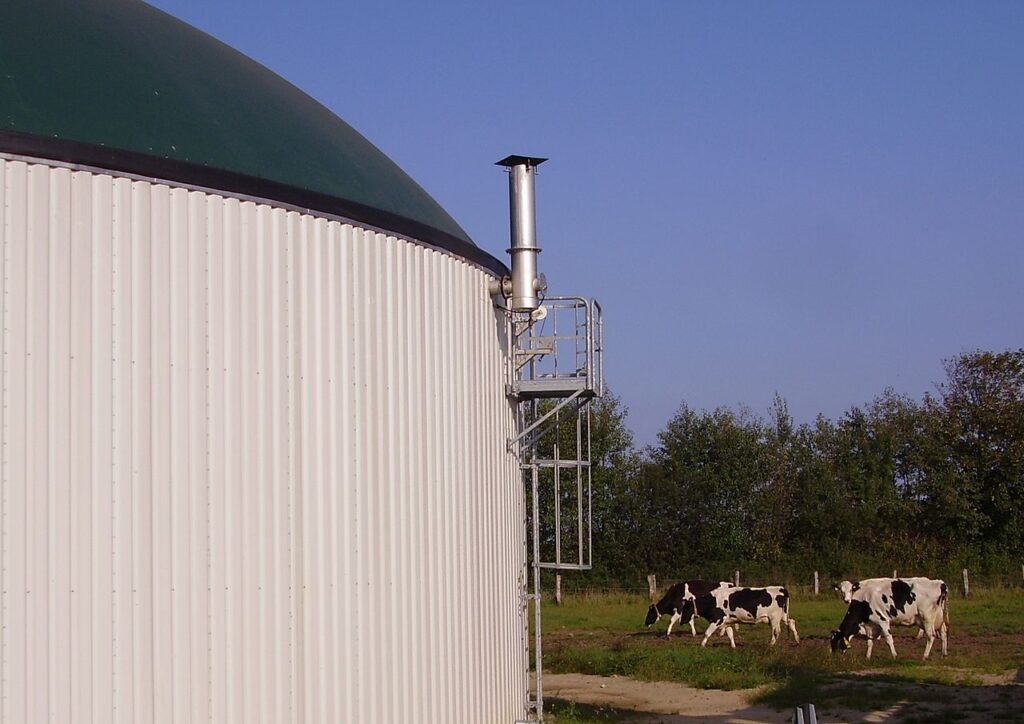What are anaerobic digesters?
Anaerobic digesters capture emissions from organic waste — like manure or food scraps — to create energy. In the United States, the majority of these systems, which are sometimes called “dairy digesters,” are installed on farms. Manure from livestock serves as the source material for the digester tank, which is also called a reactor. These tanks are anaerobic environments, meaning they have no oxygen. Bacteria that thrive in these conditions live in the digesters and break down organic material. As they do so, they release a gas composed of methane, carbon dioxide, and trace amounts of other gasses. This product, often called “biogas,” can then be captured and either burned directly or purified into methane-based natural gas. Anaerobic digestion also creates leftover organic material called digestate, which can be used for fertilizer and livestock bedding.
Where are digesters installed?
In the United States, more than 80 percent of anaerobic digesters are installed on dairies, with the rest found on swine, poultry, and cattle farms, as well as landfills and wastewater treatment facilities.
Digesters are installed on farms that use lagoons to store liquid manure. This form of manure management is used on large farms (more than 1,000 cows) because many animals are kept in barns, and the manure they produce is removed with water. This liquid manure mix is then pushed into large open lagoons. Because the manure is breaking down without access to oxygen in these lagoons, a significant amount of methane is released. Pasture farms, which have fewer cattle than large farms, allow dropped manure to break down on the pasture in the presence of oxygen. As a result, this manure does not release as much methane when it breaks down.
Livestock manure management accounts for nine percent of U.S. methane emissions. Digesters reduce the methane emissions from liquid lagoons by covering them and trapping gasses that would otherwise be released into the atmosphere. Between 1990 and 2020, methane emissions from livestock waste in the United States increased 71 percent.
How much do digesters cost and who pays for them?
Digesters vary in cost, depending on their size and the technology used. In California, which has installed the majority of new digesters due to state funding, a digester for a dairy with less than 5,000 cows cost $4.7 million in 2022. A digester for a dairy with up to 14,000 cows cost $9.7 million. As of September 2022, the California Dairy Digester Research and Development program had approved grant requests for projects that cost an average of $5.1 million each, with program grants covering an average of 31 percent of total costs. These digesters have been installed on farms with anywhere from 1,000 to 14,000 cows.
There are two state programs which offset the costs of a digester in California. The Dairy Digester Research and Development program provides grants to install an anaerobic digester and the Low Carbon Fuel Standard (LCFS) pays farms for the biomethane gas which is captured by digesters. The California Department of Food and Agriculture (CFDA) has awarded $213 million for 131 digester installations since 2015, and the program funds up to half of the digester’s cost. From 2015 to 2019, the maximum award was $3 million and has been reduced to a maximum of $2 million.
The remaining costs to install a digester can be paid by farm owners or a third party.
The Low Carbon Fuel Standard in California buys biomethane gas captured from digesters. Dairies sell a credit of this gas to the LCFS, and oil refineries and distributors have to buy these credits because their product is rated over the California Air Resources Board’s carbon intensity limit.
Farms with digesters can sell their biomethane to the Low Carbon Fuel Standard even if they are not located in California.
Who owns and operates anaerobic digesters?
Digesters can be owned and operated by farmers, owned and operated by a third party, or owned by farmers and operated by a third party. Ninety-five percent of California’s digester grants have gone towards projects operated by Maas Energy Works and California Bioenergy, which own or finance the digester on partnering farms. Maas Energy Works and California BioEnergy organize the sale of resulting biogas or electricity to California’s Low Carbon Fuel Standard. California Bioenergy has partnered with Chevron and BMW to fund some digester installations. Maas Energy Works has partnered with Toyota to fund a pipeline which transports natural gas from dairies in California to existing natural gas pipelines.
What do farmers do with biogas?
Since California has the most digesters in the United States, it also has the most data available on how biogas is used. While a few projects built in 2015 burned the biogas to create electricity that was fed into the electric grid, the most common application of biogas is upgrading it to natural gas. As of January 2023, two projects use fuel cells to convert biogas to electricity without combustion.
Natural gas emanating from biogas is pumped into natural gas pipelines and can be used for vehicle fuel or general natural gas sales.
Outside of California, biogas converted to natural gas is less common. Out of 416 digesters in the country, 193 produce natural gas. Many operations use the biogas to fuel on-site generators instead.

